The current world is driven by technology, which changes at a very fast rate. The web development space is also evolving fast. Developers will always yearn for efficient and effective tools to create web apps. There is more demand regarding a given web project’s scalability, performance, maintainability, and success. The demand calls for the best features, and choosing the appropriate web development framework will make the difference.
Current web development trends tend to shift toward frameworks offering more than just a way to structure code. Developers opt for frameworks that can handle everything from server-side rendering to static site generation, bringing optimal results regarding developer experience and performance. As the technology evolves, Astro and Next.js have emerged as two of the most notable contenders when you mention web development frameworks. They have unique features, ease of use, performance capabilities, and unique approaches to creating web apps.
Next.js is a popular open-source framework created on top of React and is popular among developers looking forward to easily creating server-rendered React apps. It focuses more on automatic code-splitting, built-in API routes, and hybrid rendering, making it a great choice for projects requiring server-side rendering and static site generation abilities. Therefore, many developers opt for Next.js for its ease of use, strong community support, and extensive documentation, and it can apply to small projects and even large-scale enterprise apps.
Regarding Astro, we realize it is a new player promising an innovative take on web development. It is an innovative static site generator aiming at delivering the fastest possible websites leveraging built-in optimizations, multi-framework support, and partial hydration. Many developers looking forward to building highly performant static sites that are SEO-friendly out of the box will opt for Astro.
This article aims at comparing the two frameworks. We will look at different aspects, including the key features, use cases, and the benefits of the frameworks, to better understand their strengths and limitations. Such information is critical to you, especially as a developer, to help you understand comprehensively and know the framework that will best suit your project. Your choice will depend on your users’ development goals and needs. Get the deeper knowledge to help you create that simple static site or the complex web app.
Overview of Astro
Astro is a new cutting-edge web development framework created on a stable React foundation. This framework aims to produce fast, lightweight static websites. Developers have a chance to create websites with less client-side JavaScript, a good way of improving load times and performance. Developers can use UI components coming from numerous popular JavaScript frameworks. It enhances flexibility and creativity. Being a templating language, Astro has a simple learning curve, especially for those developers coming from JSX or HTML. Such developers can easily create reusable components and layouts.
Astro is versatile and can help build fast, content-rich websites, server APIs, and apps. You can use it to create static websites and those that need server-side rendering environments. It has the Islands Architecture feature, a great approach separating the static content of a website from the interactive parts. The results are sleek, fast, and efficient websites, which improve performance since JavaScript-to-HTML streaming is automatic.
Astro aims to improve general performance and stands to the promise of delivering exceptional developer experience. Developers at all skill levels can easily access and use the framework, which reduces unnecessary complexity. It is a good choice for beginners and experienced web developers.
Core Features
Astro has a philosophical approach that says less is more, especially regarding client-side JavaScript (where most performance issues lie). The framework allows developers to create apps rendering only essential JavaScript to users, a great way to achieve faster load times and an amazing user experience. Astro is powerful in building optimized applications alongside static site generation capabilities.
Here are some of the amazing key features that define the Astro framework:
- Astro is a component-based architecture supporting multiple frameworks or UI component languages. It supports multiple front-end frameworks like Vue, Svelte, and React, allowing developers to write components using their framework of choice instead of locking them to a particular technology. Such flexibility, coupled with static site generation features, results in efficient pre-rendering of web pages at build time for fast delivery to users.
- Partial hydration. Unlike traditional frameworks that rehydrate the entire page with JavaScript, Astro allows developers to selectively hydrate components based on user interaction. This means a page can remain mostly static, with JavaScript loaded only for components requiring interactivity. Astro aims to improve load times by making available the minimum essential code of JavaScript required and delivering it to the client for the app to function. If you need to use a contact form, Astro avails JavaScript needed for the particular form instead of loading the entire code for the website.
- Markdown support. Astro is a strong framework supporting Markdown files out-of-the-box without needing custom configurations or other plugins. Developers use this feature in building content-rich applications like documentation sites or blog posts.
- Flexible rendering. Astro is known to support client-rendering, server-rendering, and static site generation. This is a flexible approach that developers use in creating web apps. It is possible to select the appropriate rendering method for every website section, which maximizes optimal user experience and performance. It is possible to selectively enable server-side rendering to particular components or pages requiring dynamic data and still enjoy the advantages of static generation for the other app sections.
- Built-in optimizations. Developers can use Astro to optimize the performance of the web app. Such approaches include inlining critical CSS, minifying the HTML, CSS, and JavaScript codes, and lazy-loading images. Such optimizations are good at increasing the website speed and ensuring a great user experience.
Unique Selling Points
- Performance Optimization: With Astro’s focus on minimal client-side JavaScript and partial hydration, applications built using Astro are fast, increasing user engagement and SEO rankings.
- Framework Agnosticism: Astro allows utilizing components from different front-end frameworks within the same project. There is much flexibility, and teams can use existing skills and libraries.
- Developer Experience: Astro focuses on simplicity and performance, giving developers the best experience. They enjoy amazing features like fast build times, an intuitive templating syntax, and out-of-the-box support for TypeScript and CSS modules.
Next.js: A Brief Overview
As we have noted from the start of this article, the web development space is ever-evolving. Frameworks come into play as great tools offering efficiency, flexibility, and powerful features. Among the frameworks is Next.js.
Next JS is a popular open-source, full-stack React framework that allows developers to create server-rendered React apps. Many love it for its powerful development experience with wonderful features like built-in routing, automatic code splitting, data fetching abilities, hot module replacement, and unique server-side rendering. Next JS is popular for handling large-scale projects, and you can easily scale it to address the ever-changing user requirements. You will meet a large and active community, meaning the availability of great tutorials, resources, plugins, and tools at your disposal as a developer.
Background and Emergence
Vercel (formerly known as Zeit) introduced Next.js, aiming to solve some of the common challenges React developers faced. Such issues revolved around routing and configuration. Next.js hoped to provide a great, streamlined solution for server-side rendering (SSR) to ensure faster page loads, enhancing the SEO and the general user experience. With time, Next.js has gone through an evolution with added features like static site generation (SSG), automatic code splitting, and API routes, and it has become a versatile tool many developers use in their web projects.
Core Features and Functionalities
- Server-Side Rendering (SSR): This framework is less powerful in offering rich client-side performance and built-in optimization methods than Astro. However, it compensates for this with SSR and API routes. Next.js allows for rendering React components on the server, enhancing the initial load times and optimizing search engine by delivering fully rendered pages to the browser. It makes the React app more efficient on the client side by offloading data-fetching activities to the server.
- Static Site Generation (SSG): Next JS uses the getStaticProps and getStaticPaths functions, enabling the pre-rendering of pages at build time to facilitate the creation of ultra-fast static websites that you can easily deploy to a CDN.
- Automatic Code Splitting: The framework automatically splits your code into smaller bundles, ensuring that only the necessary code is loaded for each page. This contributes to faster page loading times and an improved or optimal user experience.
- API Routes: The framework has built-in support for API routes, allowing developers to build API endpoints as part of their Next.js application. This feature enables the seamless connection and building of full-stack applications on a single framework without requiring a separate backend. Front-end apps and back-end services are seamlessly connected.
- Built-in CSS and Sass Support: The framework offers support for built-in CSS and Sass, simplifying the process of styling applications. Next.js allows for component-level styles with CSS modules or global stylesheets.
- Support for TypeScript: The framework has built-in support for TypeScript, a great approach for adding static typing for the project. This feature facilitates catching potential bugs during development, ensuring your app is robust.
- Optimizing development and production: The framework helps optimize your app for development and production environments. You get features like hot module replacement that allow you to see all the app changes without reloading the full page.
The Ecosystem and Integration
Next.js has lots of capabilities supported by its uniquely rich and robust ecosystem. You get an array of plugins, integrations, and community contributions. The next/image component helps in optimizing image handling. The framework has several features, like analytics support and internationalization features, that support modern web development. It is compatible with several backend services and APIs, giving developers flexibility when integrating authentication services, third-party APIs, and databases.
There is a large number of learning resources available, including courses, tutorials, and official documentation. The community support is also very vibrant, welcoming, and active in offering help and sharing insights on best practices through social media, online platforms, and forums.
Astro vs Next JS: Comparison
Use case:
- Next.js is ideal for apps requiring dynamic data or server-side rendering. Examples could be e-commerce sites, apps with real-time data, or blogs that require frequent updating (news websites).
- Astro: Ideal for static sites or sites containing static content, such as portfolios, documentation sites, or blogs. Astro is good when you want to create a personal portfolio site that showcases your skills and work since it focuses on performance and supports different frameworks.
Performance:
- Next.js: Automatic code splitting and hybrid rendering results in excellent performance. Even with increased complexities, the framework ensures the app maintains high responsiveness and fast performance.
- Astro: The framework supports multiple frameworks, partial hydration, and built-in optimizations to guarantee maximum performance. Such are great options for improving load times and the best user experience, particularly for content-heavy websites.
Learning curve:
- Next.js: You need prior knowledge of React and be familiar with SSG and SSR concepts. However, a large community and extensive documentation make learning easy for developers well-versed in React.
- Astro: You can easily learn if you understand HTML, CSS, and JavaScript. Even for those unfamiliar with them, Astro provides intuitive syntax and thorough documentation that you can easily use to learn the new framework.
Ecosystem and community:
- Next.js: It has a large, active community and a rich ecosystem of resources, libraries, and plugins.
- Astro: Being a newer framework, the community is small, and the ecosystem is still growing. The community is so welcoming and active, and the ecosystem is expanding with many more developers adopting the framework
Integrations and extensibility
- Astro: It has a complete page dedicated to integrations, accessibility plugins, and supporting libraries like Vue and React.
- js: Uses next.config.js file for customizability and integrating plugins. No dedicated website for all plugins.
Hydration
Astro supports partial hydration, allowing for the compilation of non-interactive components into plain HTML and serving them to the end user. Next.js doesn’t support partial hydration; it uses traditional methods by simultaneously loading and hydrating all components that need client-side JavaScript.
Code Splitting
Code splitting splits the app into smaller units to help optimize, resulting in faster initial loading times and enhanced performance.
Astro does not currently support code splitting but leverages existing bundlers like Snowpack or Webpack.
Next.js supports code splitting, a good feature for big apps with complex codebases.
Conclusion
We have already seen that Next.js and Astro are unique in their own capacities. They are powerful frameworks, rich in features to meet demands for different use cases. Next.js is good for dynamic, large-scale apps requiring data handling, a well-established ecosystem, server-side rendering, and robust features. Astro is the best consideration if you need to prioritize performance and want to take advantage of multiple web frameworks targeting static websites. It boils down to the project requirements, team expertise, familiarity with a given framework, and personal preferences.
Any queries? Connect with our web development company : Aalpha information systems!
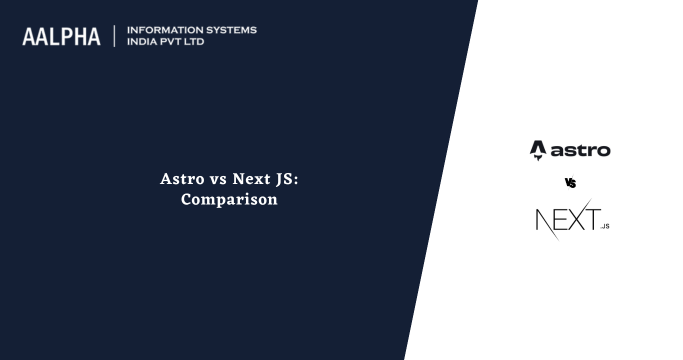

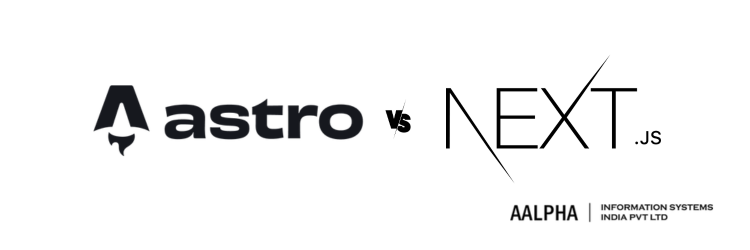
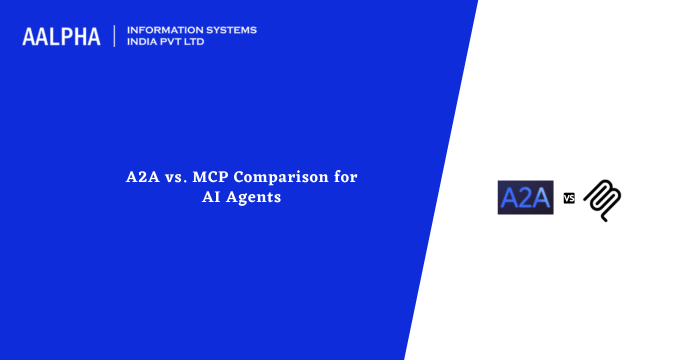
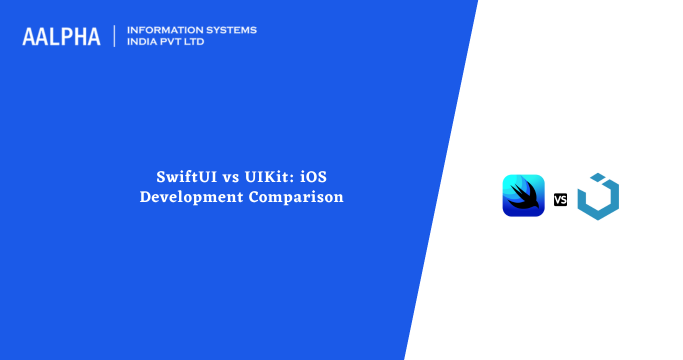
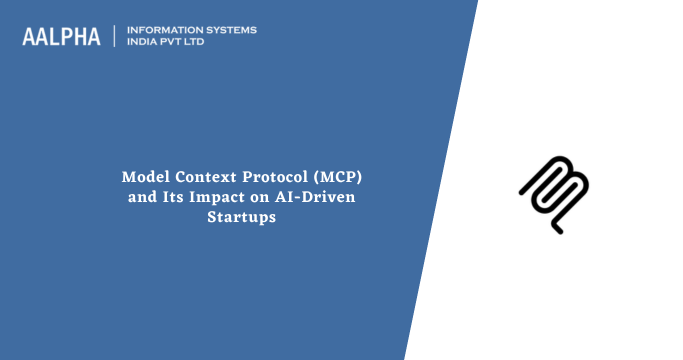
Share This Article:
Written by:
Stuti Dhruv
Stuti Dhruv is a Senior Consultant at Aalpha Information Systems, specializing in pre-sales and advising clients on the latest technology trends. With years of experience in the IT industry, she helps businesses harness the power of technology for growth and success.
Stuti Dhruv is a Senior Consultant at Aalpha Information Systems, specializing in pre-sales and advising clients on the latest technology trends. With years of experience in the IT industry, she helps businesses harness the power of technology for growth and success.